Workgroup Behaviour Analysis: Case Study of a New Zealand Factory
VerifiedAdded on 2023/04/03
|8
|1774
|109
Case Study
AI Summary
This case study analyzes the workgroup behavior within the water removing section of a New Zealand factory. The study examines the norms established by the five male employees aged 18-25, their reasons for arising, and their effects on the members, group, and factory. The employees exhibited unethical and lazy behavior due to poor supervision, low wages, and a lack of strict governance. The group displayed high cohesiveness, with strong bonds and shared behaviors like taking long breaks and manipulating work schedules, which negatively impacted productivity and factory operations. The study recommends strict rules, setting targets, appointing supervisors, increasing wages, implementing incentive schemes, and introducing technology to improve employee performance and generate revenue. The provided recommendations aim to foster a more productive and disciplined work environment by leveraging the group's cohesiveness for the benefit of the factory.
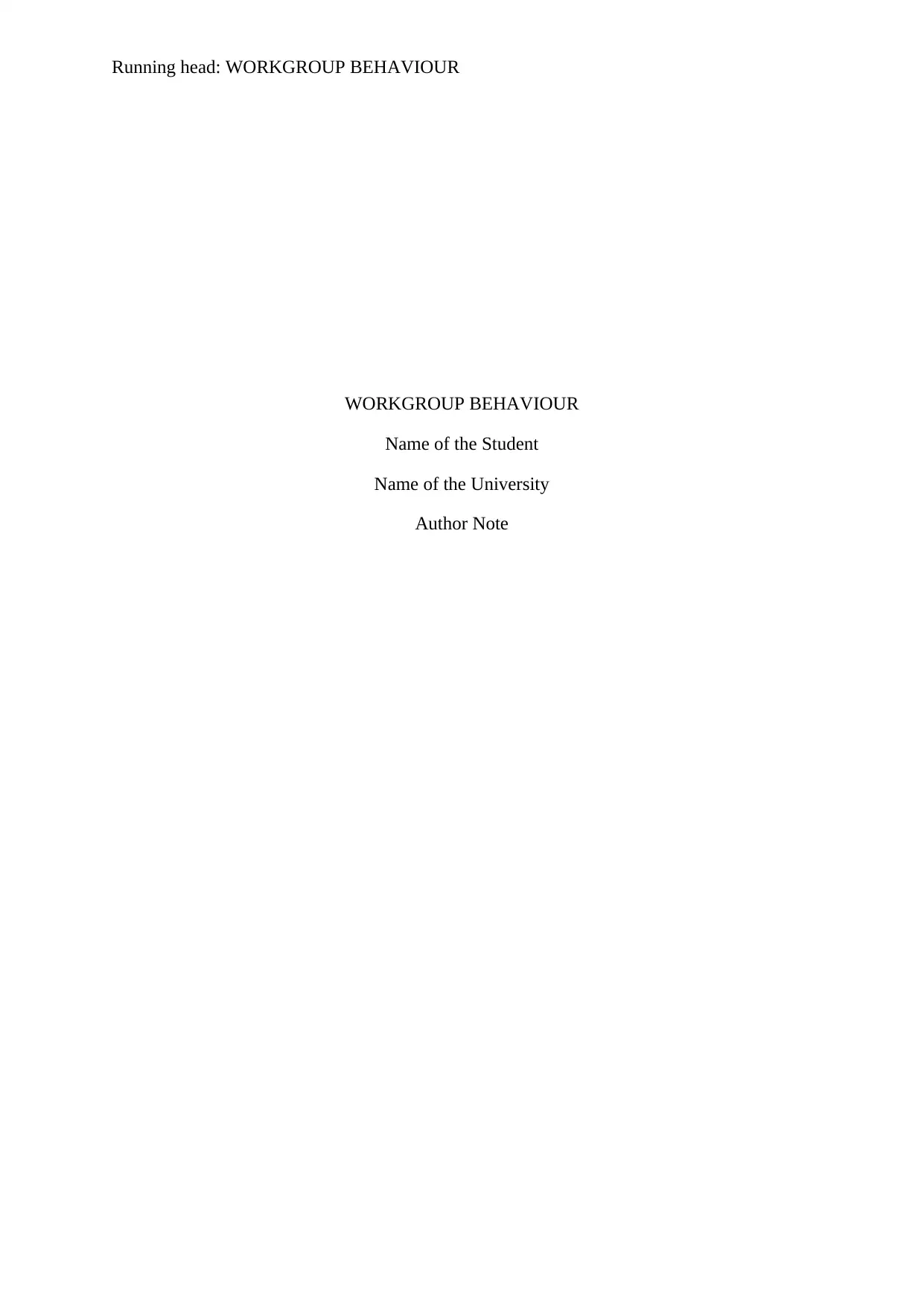
Running head: WORKGROUP BEHAVIOUR
WORKGROUP BEHAVIOUR
Name of the Student
Name of the University
Author Note
WORKGROUP BEHAVIOUR
Name of the Student
Name of the University
Author Note
Paraphrase This Document
Need a fresh take? Get an instant paraphrase of this document with our AI Paraphraser
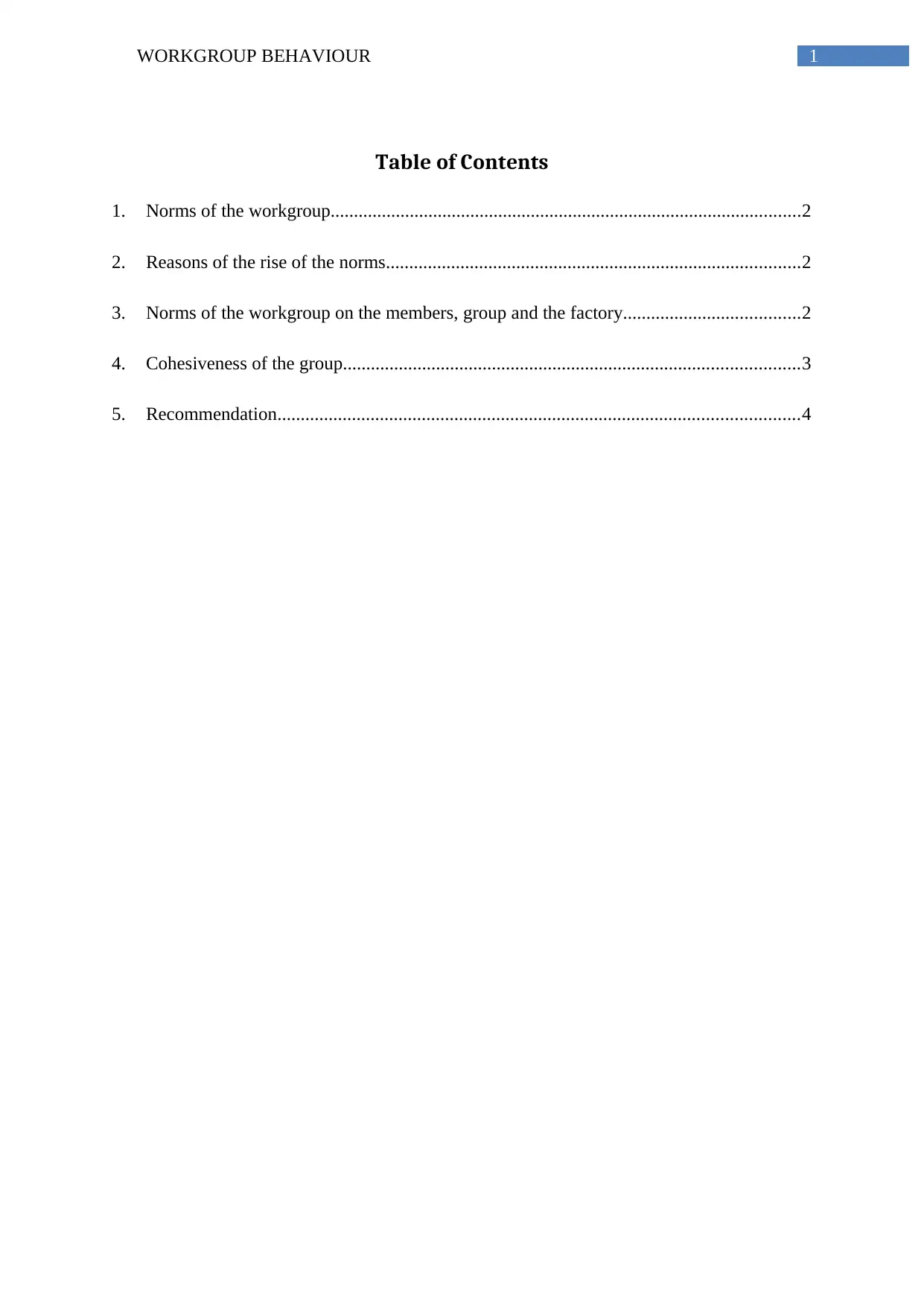
1WORKGROUP BEHAVIOUR
Table of Contents
1. Norms of the workgroup.....................................................................................................2
2. Reasons of the rise of the norms.........................................................................................2
3. Norms of the workgroup on the members, group and the factory......................................2
4. Cohesiveness of the group..................................................................................................3
5. Recommendation................................................................................................................4
Table of Contents
1. Norms of the workgroup.....................................................................................................2
2. Reasons of the rise of the norms.........................................................................................2
3. Norms of the workgroup on the members, group and the factory......................................2
4. Cohesiveness of the group..................................................................................................3
5. Recommendation................................................................................................................4
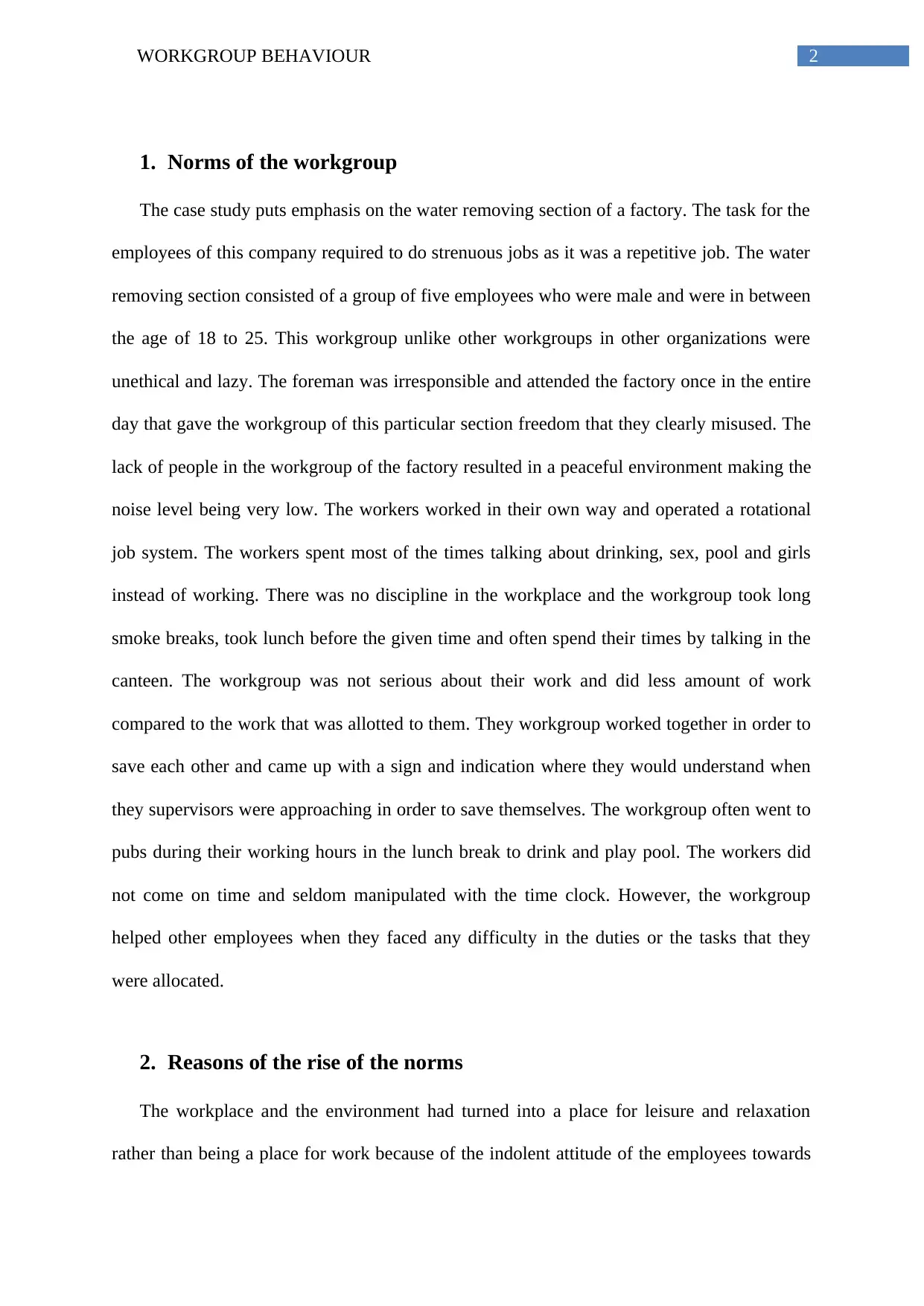
2WORKGROUP BEHAVIOUR
1. Norms of the workgroup
The case study puts emphasis on the water removing section of a factory. The task for the
employees of this company required to do strenuous jobs as it was a repetitive job. The water
removing section consisted of a group of five employees who were male and were in between
the age of 18 to 25. This workgroup unlike other workgroups in other organizations were
unethical and lazy. The foreman was irresponsible and attended the factory once in the entire
day that gave the workgroup of this particular section freedom that they clearly misused. The
lack of people in the workgroup of the factory resulted in a peaceful environment making the
noise level being very low. The workers worked in their own way and operated a rotational
job system. The workers spent most of the times talking about drinking, sex, pool and girls
instead of working. There was no discipline in the workplace and the workgroup took long
smoke breaks, took lunch before the given time and often spend their times by talking in the
canteen. The workgroup was not serious about their work and did less amount of work
compared to the work that was allotted to them. They workgroup worked together in order to
save each other and came up with a sign and indication where they would understand when
they supervisors were approaching in order to save themselves. The workgroup often went to
pubs during their working hours in the lunch break to drink and play pool. The workers did
not come on time and seldom manipulated with the time clock. However, the workgroup
helped other employees when they faced any difficulty in the duties or the tasks that they
were allocated.
2. Reasons of the rise of the norms
The workplace and the environment had turned into a place for leisure and relaxation
rather than being a place for work because of the indolent attitude of the employees towards
1. Norms of the workgroup
The case study puts emphasis on the water removing section of a factory. The task for the
employees of this company required to do strenuous jobs as it was a repetitive job. The water
removing section consisted of a group of five employees who were male and were in between
the age of 18 to 25. This workgroup unlike other workgroups in other organizations were
unethical and lazy. The foreman was irresponsible and attended the factory once in the entire
day that gave the workgroup of this particular section freedom that they clearly misused. The
lack of people in the workgroup of the factory resulted in a peaceful environment making the
noise level being very low. The workers worked in their own way and operated a rotational
job system. The workers spent most of the times talking about drinking, sex, pool and girls
instead of working. There was no discipline in the workplace and the workgroup took long
smoke breaks, took lunch before the given time and often spend their times by talking in the
canteen. The workgroup was not serious about their work and did less amount of work
compared to the work that was allotted to them. They workgroup worked together in order to
save each other and came up with a sign and indication where they would understand when
they supervisors were approaching in order to save themselves. The workgroup often went to
pubs during their working hours in the lunch break to drink and play pool. The workers did
not come on time and seldom manipulated with the time clock. However, the workgroup
helped other employees when they faced any difficulty in the duties or the tasks that they
were allocated.
2. Reasons of the rise of the norms
The workplace and the environment had turned into a place for leisure and relaxation
rather than being a place for work because of the indolent attitude of the employees towards
⊘ This is a preview!⊘
Do you want full access?
Subscribe today to unlock all pages.

Trusted by 1+ million students worldwide
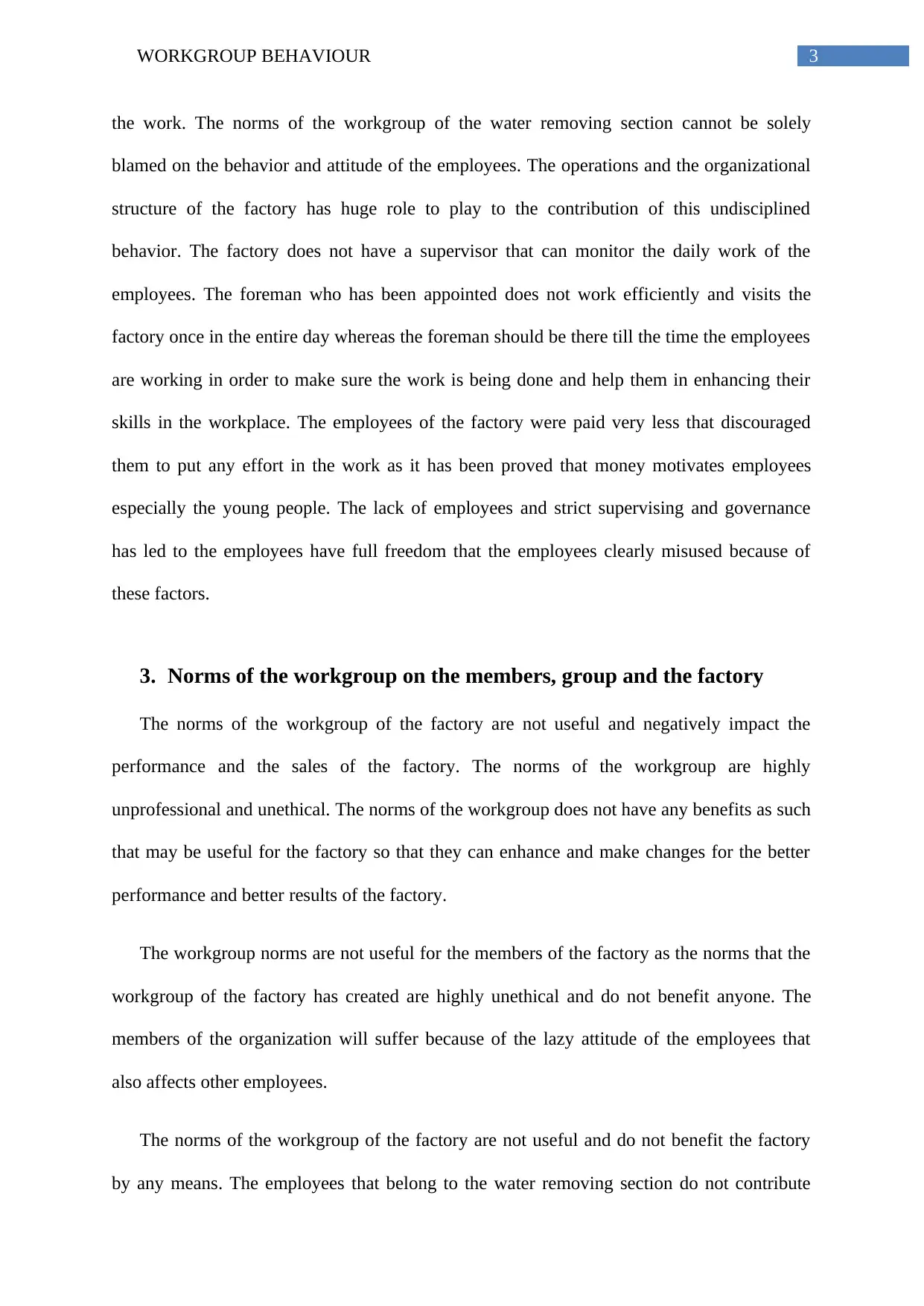
3WORKGROUP BEHAVIOUR
the work. The norms of the workgroup of the water removing section cannot be solely
blamed on the behavior and attitude of the employees. The operations and the organizational
structure of the factory has huge role to play to the contribution of this undisciplined
behavior. The factory does not have a supervisor that can monitor the daily work of the
employees. The foreman who has been appointed does not work efficiently and visits the
factory once in the entire day whereas the foreman should be there till the time the employees
are working in order to make sure the work is being done and help them in enhancing their
skills in the workplace. The employees of the factory were paid very less that discouraged
them to put any effort in the work as it has been proved that money motivates employees
especially the young people. The lack of employees and strict supervising and governance
has led to the employees have full freedom that the employees clearly misused because of
these factors.
3. Norms of the workgroup on the members, group and the factory
The norms of the workgroup of the factory are not useful and negatively impact the
performance and the sales of the factory. The norms of the workgroup are highly
unprofessional and unethical. The norms of the workgroup does not have any benefits as such
that may be useful for the factory so that they can enhance and make changes for the better
performance and better results of the factory.
The workgroup norms are not useful for the members of the factory as the norms that the
workgroup of the factory has created are highly unethical and do not benefit anyone. The
members of the organization will suffer because of the lazy attitude of the employees that
also affects other employees.
The norms of the workgroup of the factory are not useful and do not benefit the factory
by any means. The employees that belong to the water removing section do not contribute
the work. The norms of the workgroup of the water removing section cannot be solely
blamed on the behavior and attitude of the employees. The operations and the organizational
structure of the factory has huge role to play to the contribution of this undisciplined
behavior. The factory does not have a supervisor that can monitor the daily work of the
employees. The foreman who has been appointed does not work efficiently and visits the
factory once in the entire day whereas the foreman should be there till the time the employees
are working in order to make sure the work is being done and help them in enhancing their
skills in the workplace. The employees of the factory were paid very less that discouraged
them to put any effort in the work as it has been proved that money motivates employees
especially the young people. The lack of employees and strict supervising and governance
has led to the employees have full freedom that the employees clearly misused because of
these factors.
3. Norms of the workgroup on the members, group and the factory
The norms of the workgroup of the factory are not useful and negatively impact the
performance and the sales of the factory. The norms of the workgroup are highly
unprofessional and unethical. The norms of the workgroup does not have any benefits as such
that may be useful for the factory so that they can enhance and make changes for the better
performance and better results of the factory.
The workgroup norms are not useful for the members of the factory as the norms that the
workgroup of the factory has created are highly unethical and do not benefit anyone. The
members of the organization will suffer because of the lazy attitude of the employees that
also affects other employees.
The norms of the workgroup of the factory are not useful and do not benefit the factory
by any means. The employees that belong to the water removing section do not contribute
Paraphrase This Document
Need a fresh take? Get an instant paraphrase of this document with our AI Paraphraser
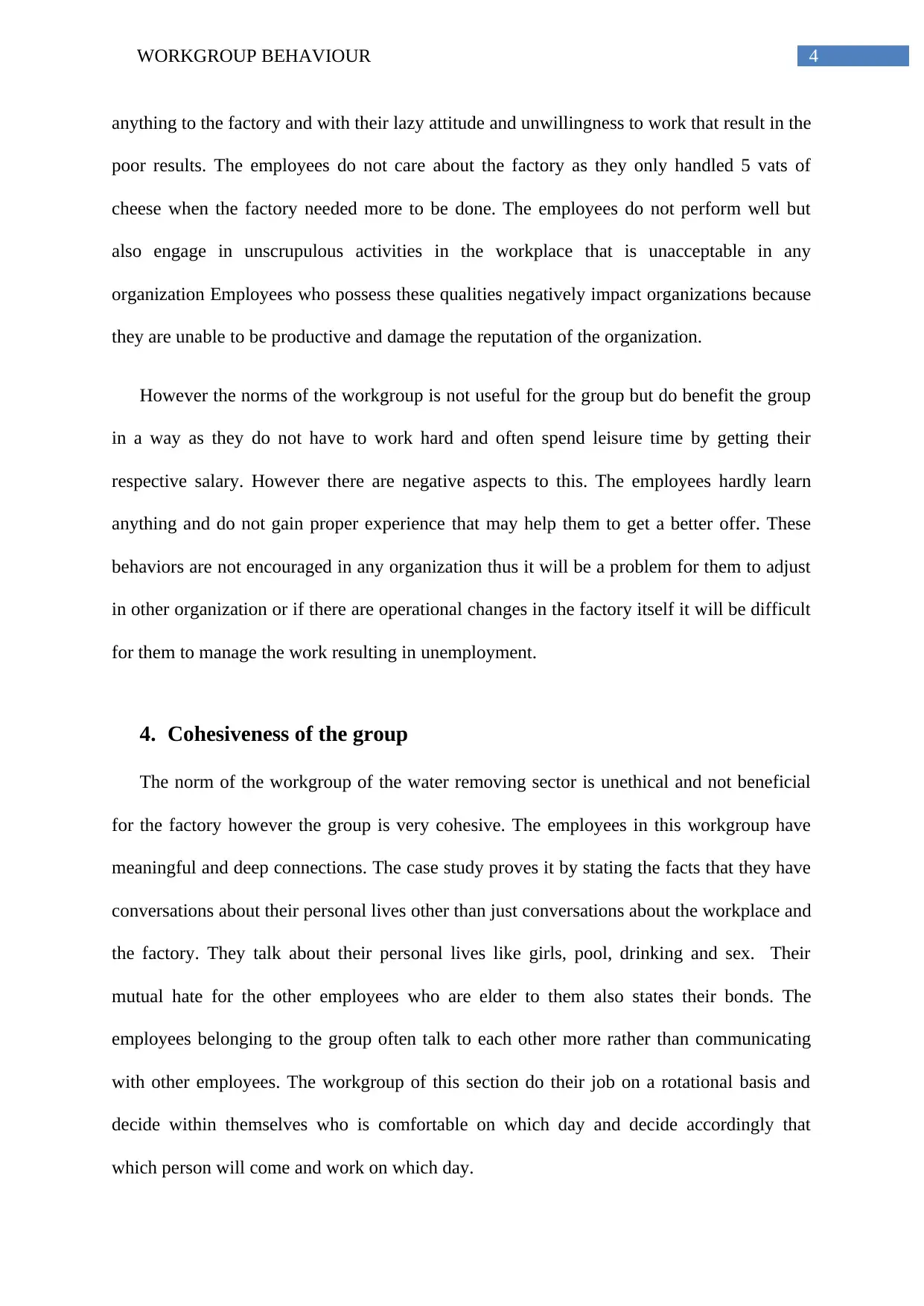
4WORKGROUP BEHAVIOUR
anything to the factory and with their lazy attitude and unwillingness to work that result in the
poor results. The employees do not care about the factory as they only handled 5 vats of
cheese when the factory needed more to be done. The employees do not perform well but
also engage in unscrupulous activities in the workplace that is unacceptable in any
organization Employees who possess these qualities negatively impact organizations because
they are unable to be productive and damage the reputation of the organization.
However the norms of the workgroup is not useful for the group but do benefit the group
in a way as they do not have to work hard and often spend leisure time by getting their
respective salary. However there are negative aspects to this. The employees hardly learn
anything and do not gain proper experience that may help them to get a better offer. These
behaviors are not encouraged in any organization thus it will be a problem for them to adjust
in other organization or if there are operational changes in the factory itself it will be difficult
for them to manage the work resulting in unemployment.
4. Cohesiveness of the group
The norm of the workgroup of the water removing sector is unethical and not beneficial
for the factory however the group is very cohesive. The employees in this workgroup have
meaningful and deep connections. The case study proves it by stating the facts that they have
conversations about their personal lives other than just conversations about the workplace and
the factory. They talk about their personal lives like girls, pool, drinking and sex. Their
mutual hate for the other employees who are elder to them also states their bonds. The
employees belonging to the group often talk to each other more rather than communicating
with other employees. The workgroup of this section do their job on a rotational basis and
decide within themselves who is comfortable on which day and decide accordingly that
which person will come and work on which day.
anything to the factory and with their lazy attitude and unwillingness to work that result in the
poor results. The employees do not care about the factory as they only handled 5 vats of
cheese when the factory needed more to be done. The employees do not perform well but
also engage in unscrupulous activities in the workplace that is unacceptable in any
organization Employees who possess these qualities negatively impact organizations because
they are unable to be productive and damage the reputation of the organization.
However the norms of the workgroup is not useful for the group but do benefit the group
in a way as they do not have to work hard and often spend leisure time by getting their
respective salary. However there are negative aspects to this. The employees hardly learn
anything and do not gain proper experience that may help them to get a better offer. These
behaviors are not encouraged in any organization thus it will be a problem for them to adjust
in other organization or if there are operational changes in the factory itself it will be difficult
for them to manage the work resulting in unemployment.
4. Cohesiveness of the group
The norm of the workgroup of the water removing sector is unethical and not beneficial
for the factory however the group is very cohesive. The employees in this workgroup have
meaningful and deep connections. The case study proves it by stating the facts that they have
conversations about their personal lives other than just conversations about the workplace and
the factory. They talk about their personal lives like girls, pool, drinking and sex. Their
mutual hate for the other employees who are elder to them also states their bonds. The
employees belonging to the group often talk to each other more rather than communicating
with other employees. The workgroup of this section do their job on a rotational basis and
decide within themselves who is comfortable on which day and decide accordingly that
which person will come and work on which day.
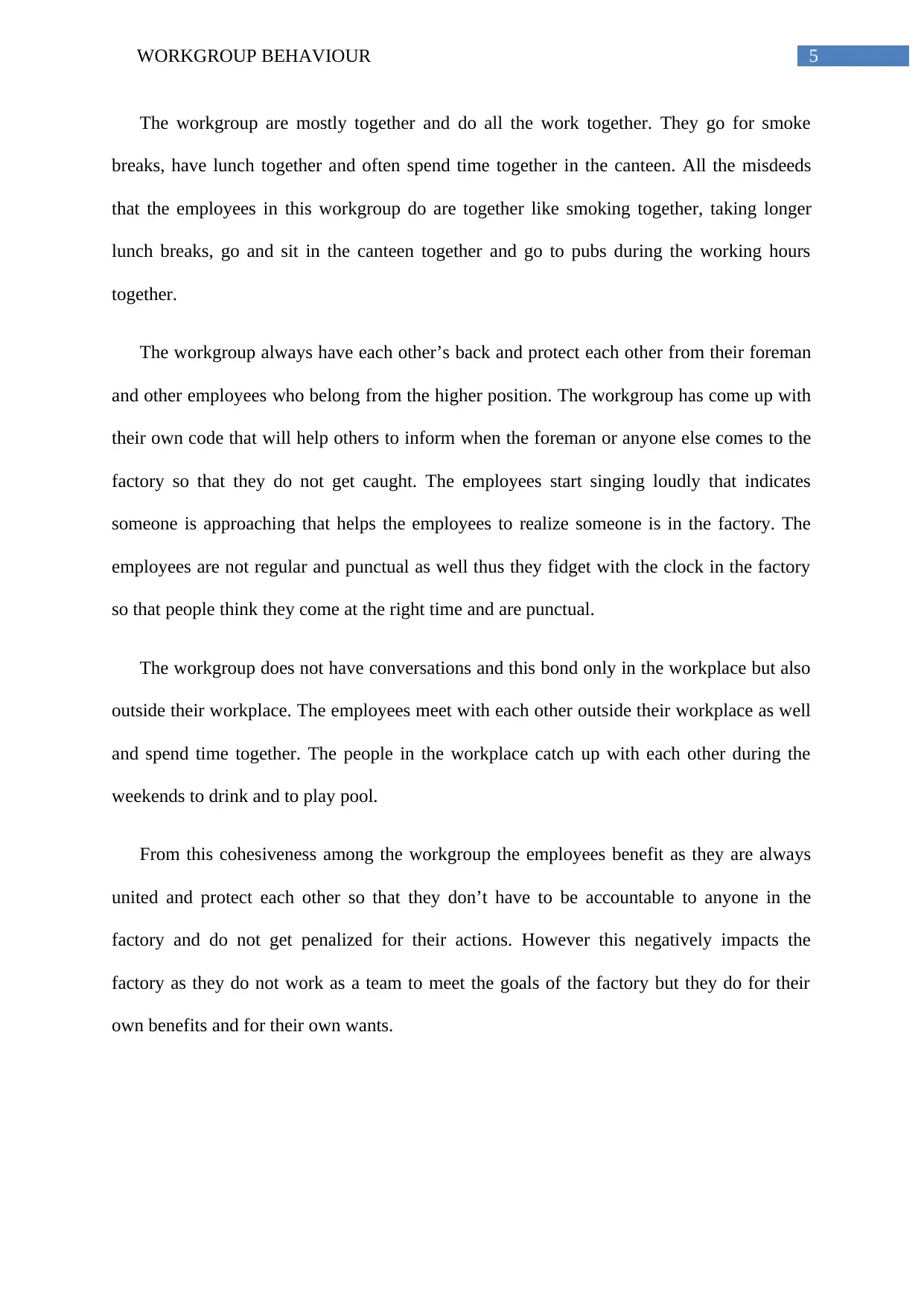
5WORKGROUP BEHAVIOUR
The workgroup are mostly together and do all the work together. They go for smoke
breaks, have lunch together and often spend time together in the canteen. All the misdeeds
that the employees in this workgroup do are together like smoking together, taking longer
lunch breaks, go and sit in the canteen together and go to pubs during the working hours
together.
The workgroup always have each other’s back and protect each other from their foreman
and other employees who belong from the higher position. The workgroup has come up with
their own code that will help others to inform when the foreman or anyone else comes to the
factory so that they do not get caught. The employees start singing loudly that indicates
someone is approaching that helps the employees to realize someone is in the factory. The
employees are not regular and punctual as well thus they fidget with the clock in the factory
so that people think they come at the right time and are punctual.
The workgroup does not have conversations and this bond only in the workplace but also
outside their workplace. The employees meet with each other outside their workplace as well
and spend time together. The people in the workplace catch up with each other during the
weekends to drink and to play pool.
From this cohesiveness among the workgroup the employees benefit as they are always
united and protect each other so that they don’t have to be accountable to anyone in the
factory and do not get penalized for their actions. However this negatively impacts the
factory as they do not work as a team to meet the goals of the factory but they do for their
own benefits and for their own wants.
The workgroup are mostly together and do all the work together. They go for smoke
breaks, have lunch together and often spend time together in the canteen. All the misdeeds
that the employees in this workgroup do are together like smoking together, taking longer
lunch breaks, go and sit in the canteen together and go to pubs during the working hours
together.
The workgroup always have each other’s back and protect each other from their foreman
and other employees who belong from the higher position. The workgroup has come up with
their own code that will help others to inform when the foreman or anyone else comes to the
factory so that they do not get caught. The employees start singing loudly that indicates
someone is approaching that helps the employees to realize someone is in the factory. The
employees are not regular and punctual as well thus they fidget with the clock in the factory
so that people think they come at the right time and are punctual.
The workgroup does not have conversations and this bond only in the workplace but also
outside their workplace. The employees meet with each other outside their workplace as well
and spend time together. The people in the workplace catch up with each other during the
weekends to drink and to play pool.
From this cohesiveness among the workgroup the employees benefit as they are always
united and protect each other so that they don’t have to be accountable to anyone in the
factory and do not get penalized for their actions. However this negatively impacts the
factory as they do not work as a team to meet the goals of the factory but they do for their
own benefits and for their own wants.
⊘ This is a preview!⊘
Do you want full access?
Subscribe today to unlock all pages.

Trusted by 1+ million students worldwide
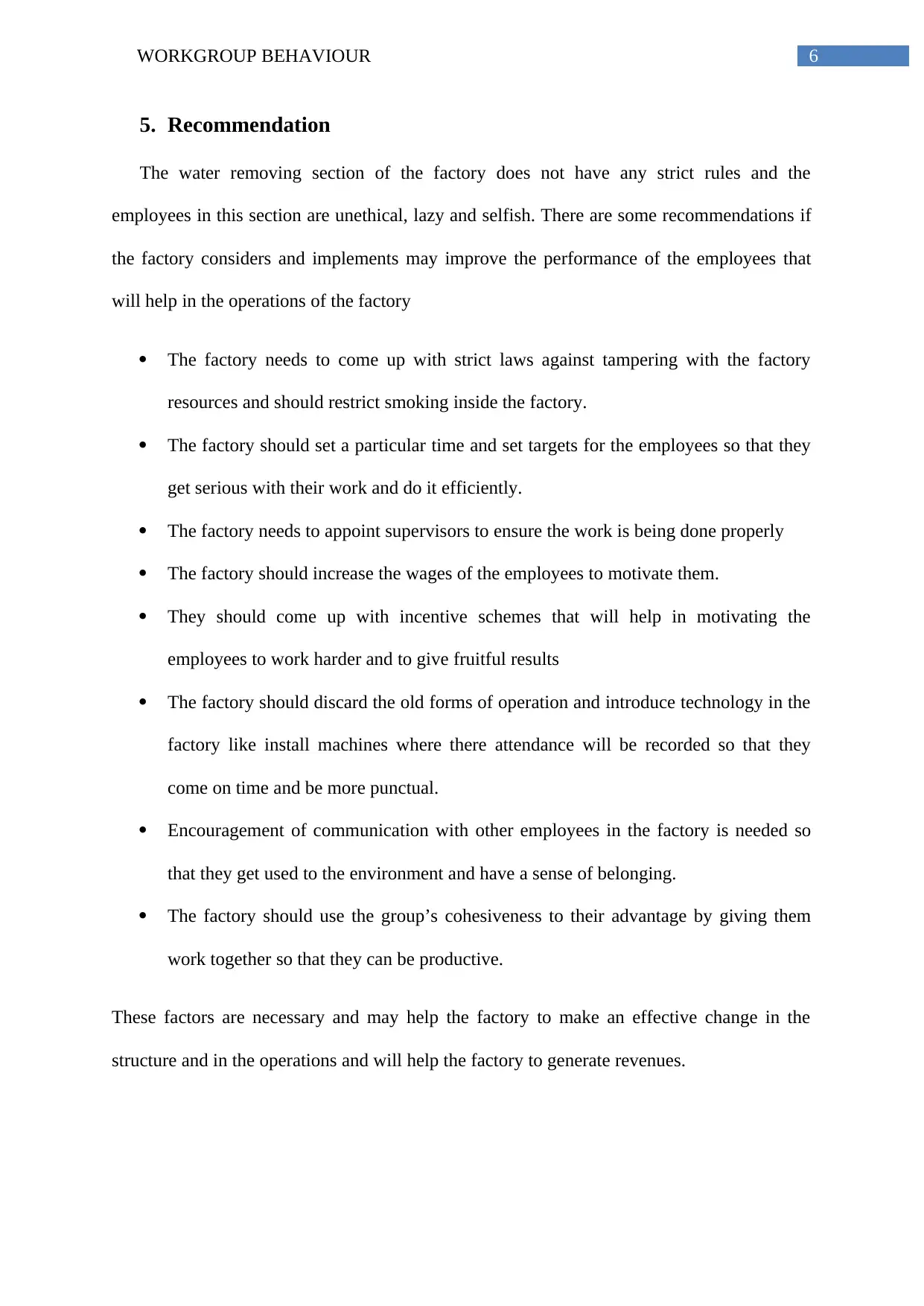
6WORKGROUP BEHAVIOUR
5. Recommendation
The water removing section of the factory does not have any strict rules and the
employees in this section are unethical, lazy and selfish. There are some recommendations if
the factory considers and implements may improve the performance of the employees that
will help in the operations of the factory
The factory needs to come up with strict laws against tampering with the factory
resources and should restrict smoking inside the factory.
The factory should set a particular time and set targets for the employees so that they
get serious with their work and do it efficiently.
The factory needs to appoint supervisors to ensure the work is being done properly
The factory should increase the wages of the employees to motivate them.
They should come up with incentive schemes that will help in motivating the
employees to work harder and to give fruitful results
The factory should discard the old forms of operation and introduce technology in the
factory like install machines where there attendance will be recorded so that they
come on time and be more punctual.
Encouragement of communication with other employees in the factory is needed so
that they get used to the environment and have a sense of belonging.
The factory should use the group’s cohesiveness to their advantage by giving them
work together so that they can be productive.
These factors are necessary and may help the factory to make an effective change in the
structure and in the operations and will help the factory to generate revenues.
5. Recommendation
The water removing section of the factory does not have any strict rules and the
employees in this section are unethical, lazy and selfish. There are some recommendations if
the factory considers and implements may improve the performance of the employees that
will help in the operations of the factory
The factory needs to come up with strict laws against tampering with the factory
resources and should restrict smoking inside the factory.
The factory should set a particular time and set targets for the employees so that they
get serious with their work and do it efficiently.
The factory needs to appoint supervisors to ensure the work is being done properly
The factory should increase the wages of the employees to motivate them.
They should come up with incentive schemes that will help in motivating the
employees to work harder and to give fruitful results
The factory should discard the old forms of operation and introduce technology in the
factory like install machines where there attendance will be recorded so that they
come on time and be more punctual.
Encouragement of communication with other employees in the factory is needed so
that they get used to the environment and have a sense of belonging.
The factory should use the group’s cohesiveness to their advantage by giving them
work together so that they can be productive.
These factors are necessary and may help the factory to make an effective change in the
structure and in the operations and will help the factory to generate revenues.
Paraphrase This Document
Need a fresh take? Get an instant paraphrase of this document with our AI Paraphraser
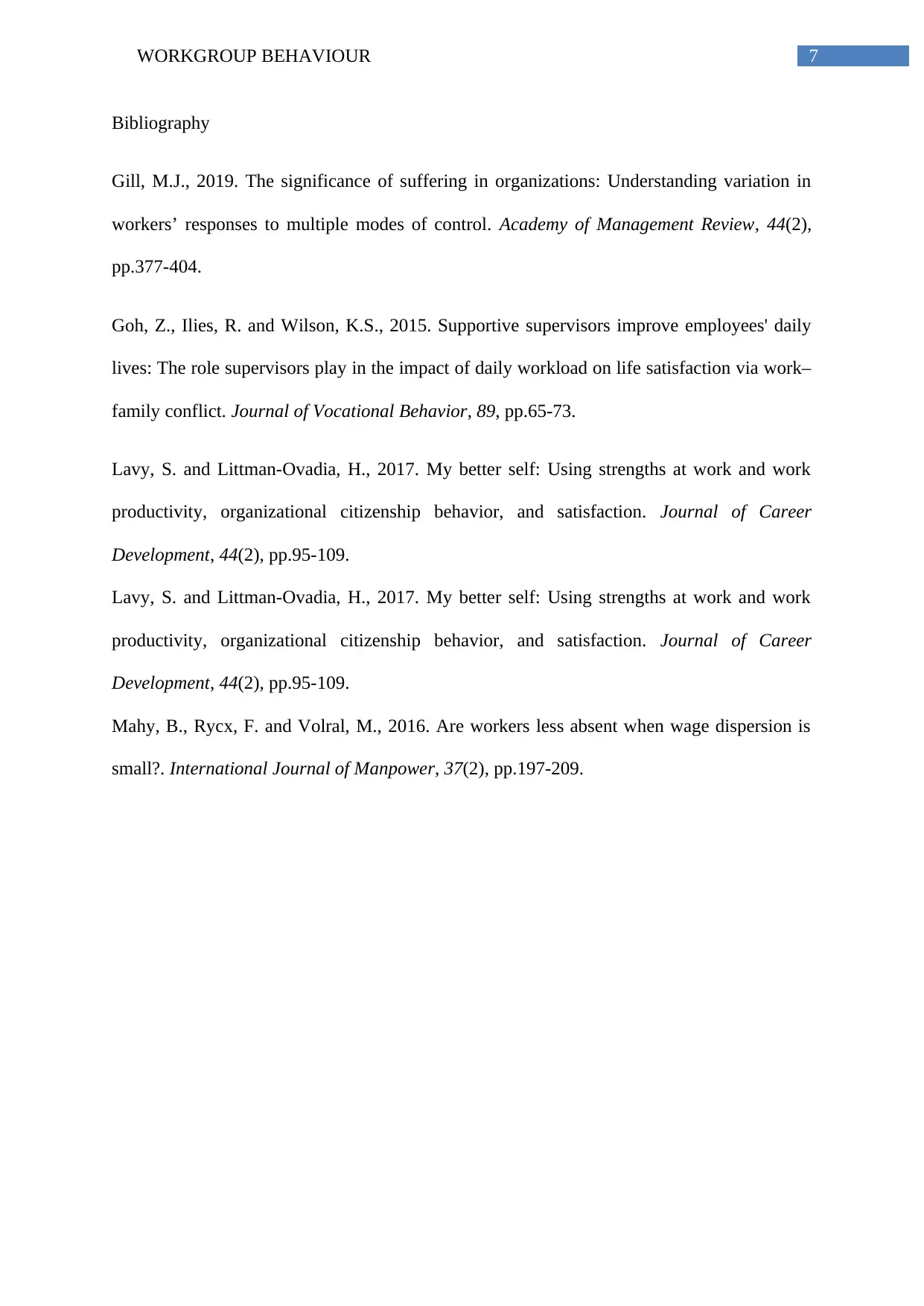
7WORKGROUP BEHAVIOUR
Bibliography
Gill, M.J., 2019. The significance of suffering in organizations: Understanding variation in
workers’ responses to multiple modes of control. Academy of Management Review, 44(2),
pp.377-404.
Goh, Z., Ilies, R. and Wilson, K.S., 2015. Supportive supervisors improve employees' daily
lives: The role supervisors play in the impact of daily workload on life satisfaction via work–
family conflict. Journal of Vocational Behavior, 89, pp.65-73.
Lavy, S. and Littman-Ovadia, H., 2017. My better self: Using strengths at work and work
productivity, organizational citizenship behavior, and satisfaction. Journal of Career
Development, 44(2), pp.95-109.
Lavy, S. and Littman-Ovadia, H., 2017. My better self: Using strengths at work and work
productivity, organizational citizenship behavior, and satisfaction. Journal of Career
Development, 44(2), pp.95-109.
Mahy, B., Rycx, F. and Volral, M., 2016. Are workers less absent when wage dispersion is
small?. International Journal of Manpower, 37(2), pp.197-209.
Bibliography
Gill, M.J., 2019. The significance of suffering in organizations: Understanding variation in
workers’ responses to multiple modes of control. Academy of Management Review, 44(2),
pp.377-404.
Goh, Z., Ilies, R. and Wilson, K.S., 2015. Supportive supervisors improve employees' daily
lives: The role supervisors play in the impact of daily workload on life satisfaction via work–
family conflict. Journal of Vocational Behavior, 89, pp.65-73.
Lavy, S. and Littman-Ovadia, H., 2017. My better self: Using strengths at work and work
productivity, organizational citizenship behavior, and satisfaction. Journal of Career
Development, 44(2), pp.95-109.
Lavy, S. and Littman-Ovadia, H., 2017. My better self: Using strengths at work and work
productivity, organizational citizenship behavior, and satisfaction. Journal of Career
Development, 44(2), pp.95-109.
Mahy, B., Rycx, F. and Volral, M., 2016. Are workers less absent when wage dispersion is
small?. International Journal of Manpower, 37(2), pp.197-209.
1 out of 8
Related Documents
Your All-in-One AI-Powered Toolkit for Academic Success.
+13062052269
info@desklib.com
Available 24*7 on WhatsApp / Email
![[object Object]](/_next/static/media/star-bottom.7253800d.svg)
Unlock your academic potential
Copyright © 2020–2025 A2Z Services. All Rights Reserved. Developed and managed by ZUCOL.




